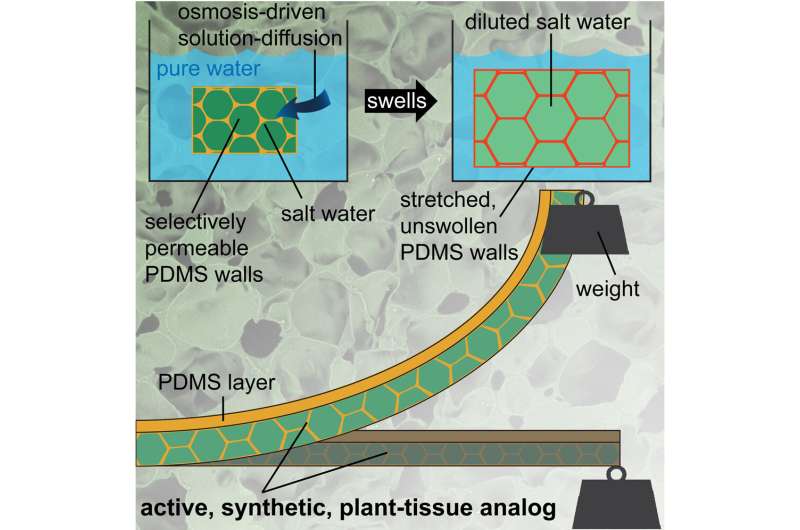November 8, 2021 report
Plant inspired silicone and saltwater composites have osmotically active response

A pair of researchers at the University of Illinois Urbana-Champaign have developed an artificial material that emulates the way that plants use fluids to defy gravity. In their paper published in the CellPress journal Matter, Amrita Kataruka and Shelby Hutchens describe their synthetic plant tissue analog and its possible uses.
As the research pair note, plants are able to push fluids from ground level up through stalks or trunks and from there out into branches or twigs to provide substance for flowers and leaves—despite having no muscle tissue. Such an ability, they note, is driven by osmosis—as water is depleted from upper cells, it is pulled from those at lower levels through permeable membranes. Kataruka and Hutchens also note that prior efforts to mimic such activity have centered around the use of hydrogels—unfortunately, such materials, they point out, tend to suffer from loss of stiffness as swelling increases due to oversaturation.
In their effort, the researchers tried a different approach, using micrometer size drops of saltwater, each embedded in tiny pouches made of polydimethylsiloxane (a type of silicone) to create artificial plant tissue. Under such an arrangement, the packet walls are both permeable and stretchable. The resulting synthetic plant tissue analog (PTA), the researchers note, works in ways very similar to live plants. When they are placed in a tank of water, for example, they reach a certain degree of stiffness and remain in that state for as long as needed—the permeability is one directional.
The stiffness results from swelling as water is absorbed, while the degree of permeability of the walls of cells and the concentration of salt in the water controls the ultimate firmness of the artificial tissue—osmotic pressure is balanced with turgor pressure. The researchers suggest their PTA represents a whole new class of aqueous materials that exhibit autonomous behavior. They further suggest that their material could be used in a wide variety of applications, ranging from soft robotics (where appendages could be made to stiffen on demand) to medical implants that can stiffen as a means of growing larger once water from the body is absorbed.
More information: Amrita Kataruka et al, Swelling of a non-vascular-plant-inspired soft composite, Matter (2021). DOI: 10.1016/j.matt.2021.10.015
Journal information: Matter
© 2021 Science X Network





















